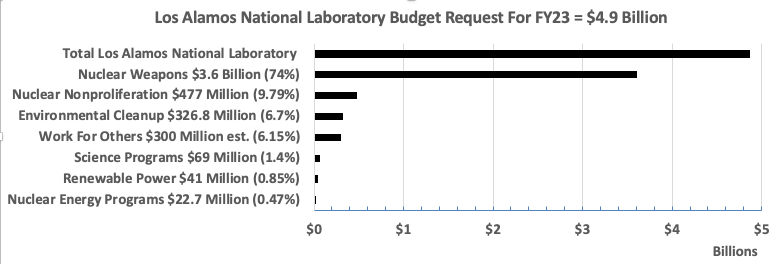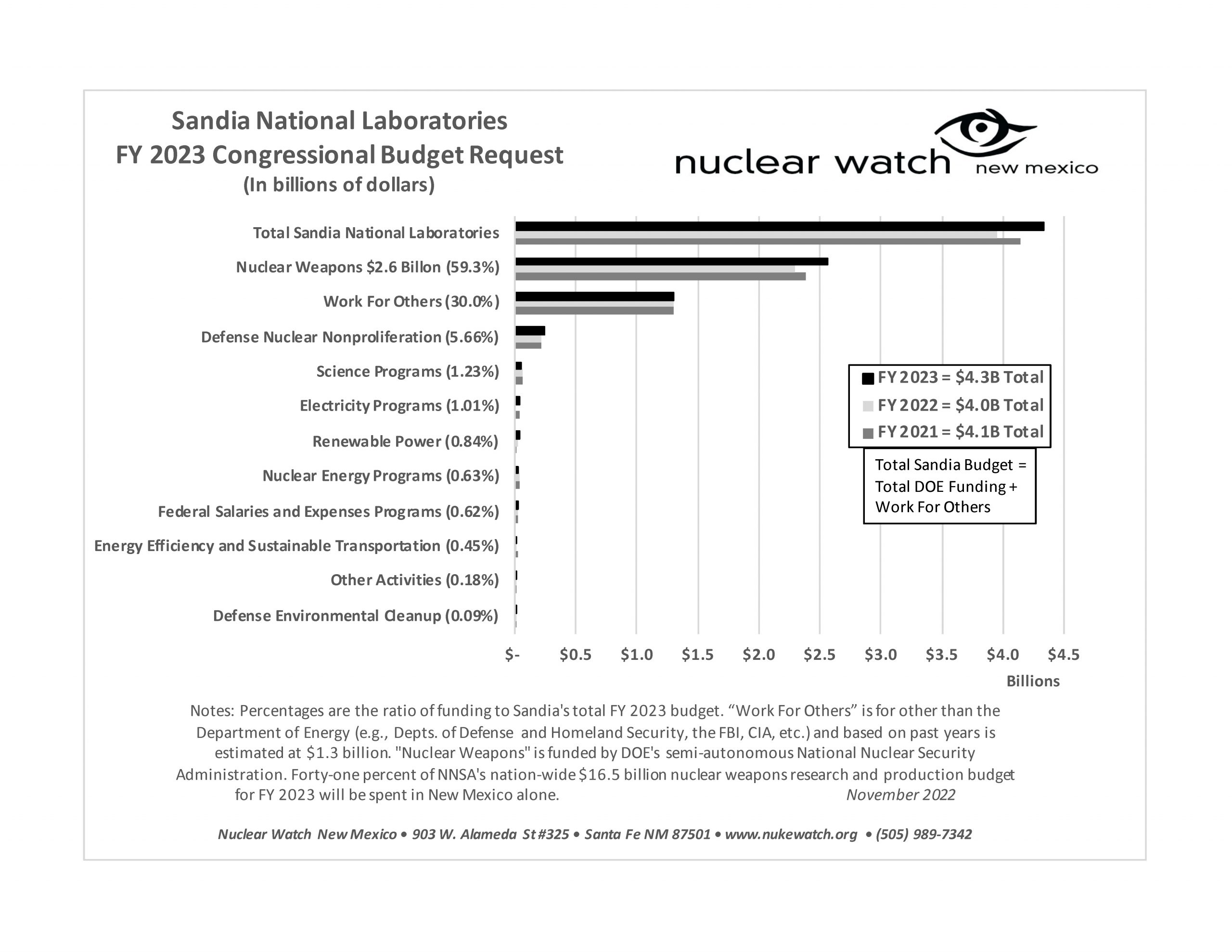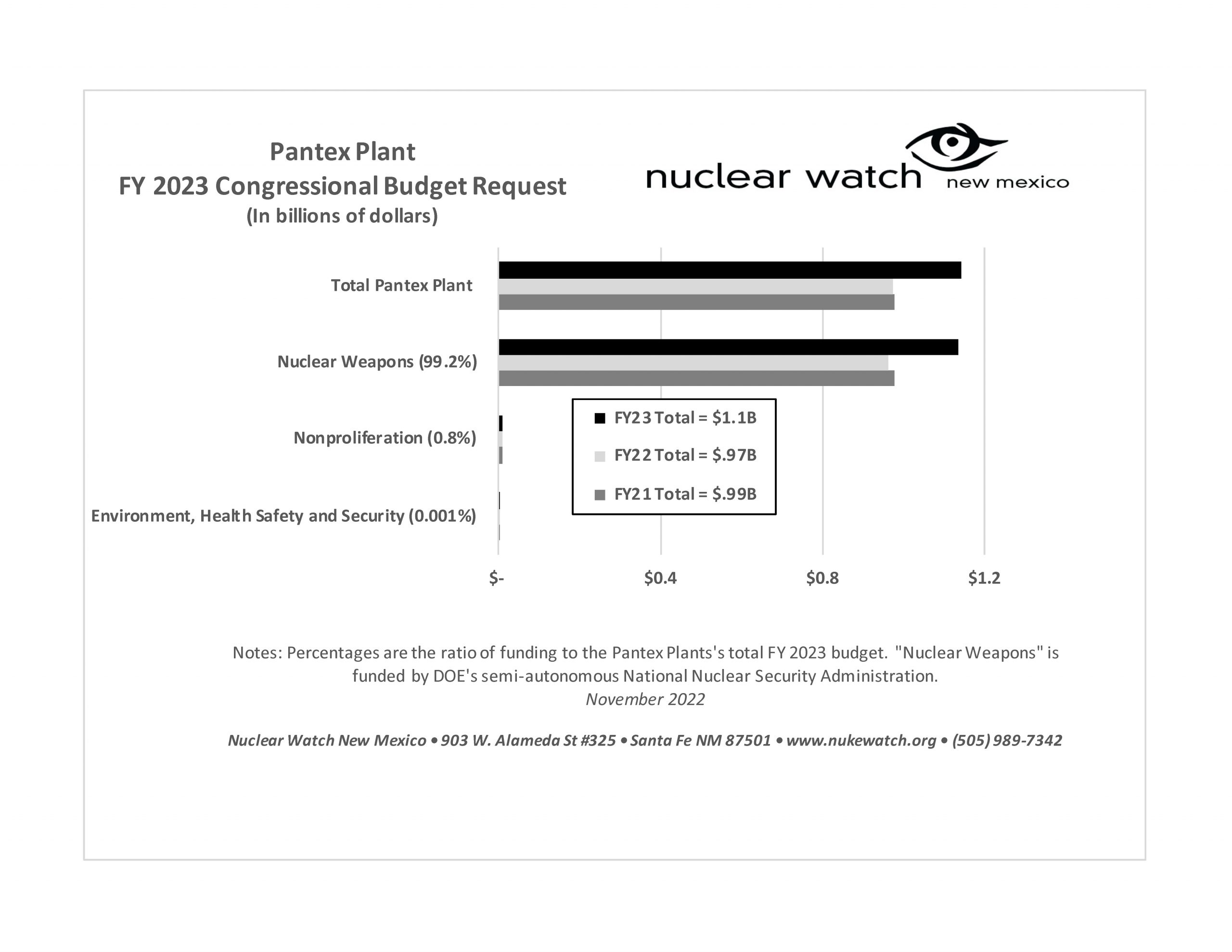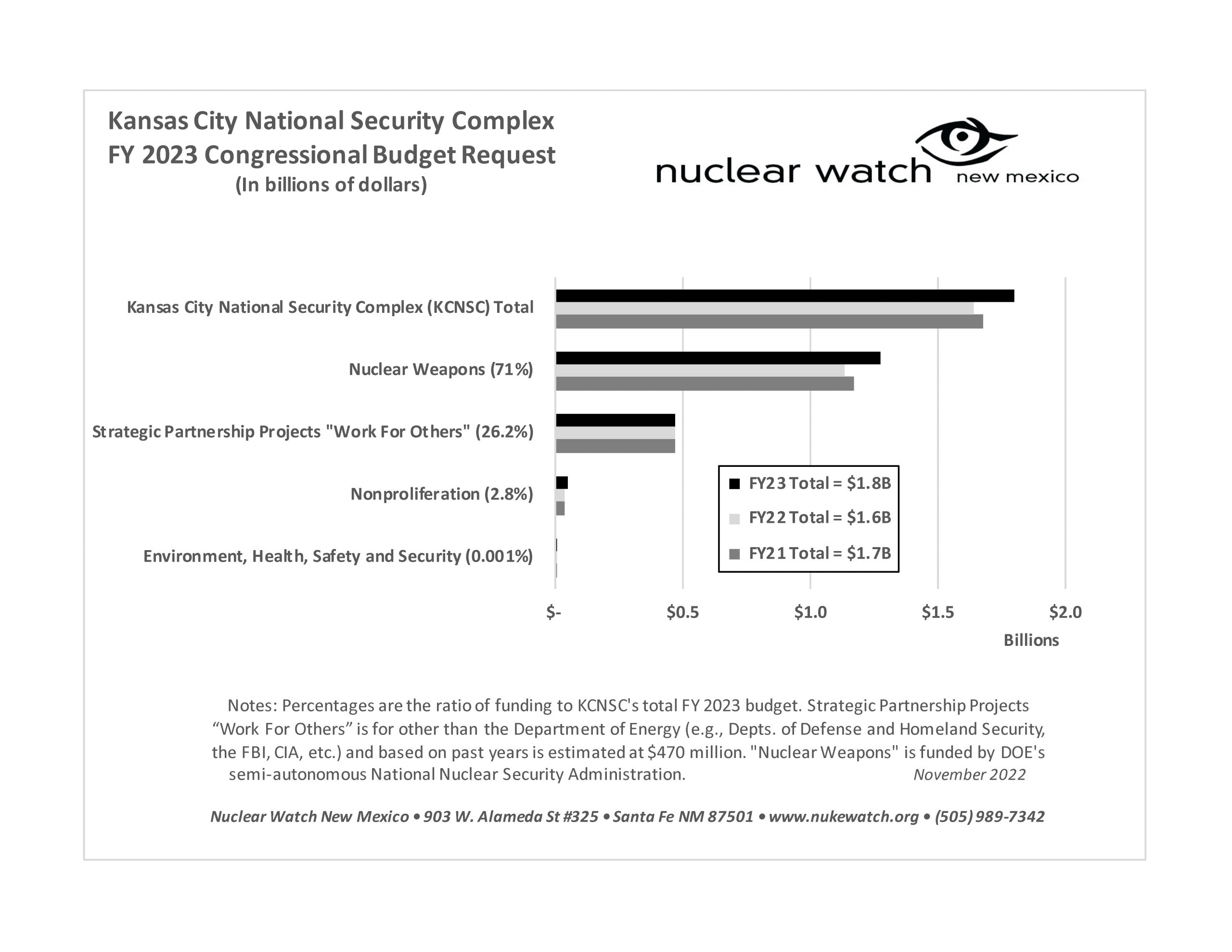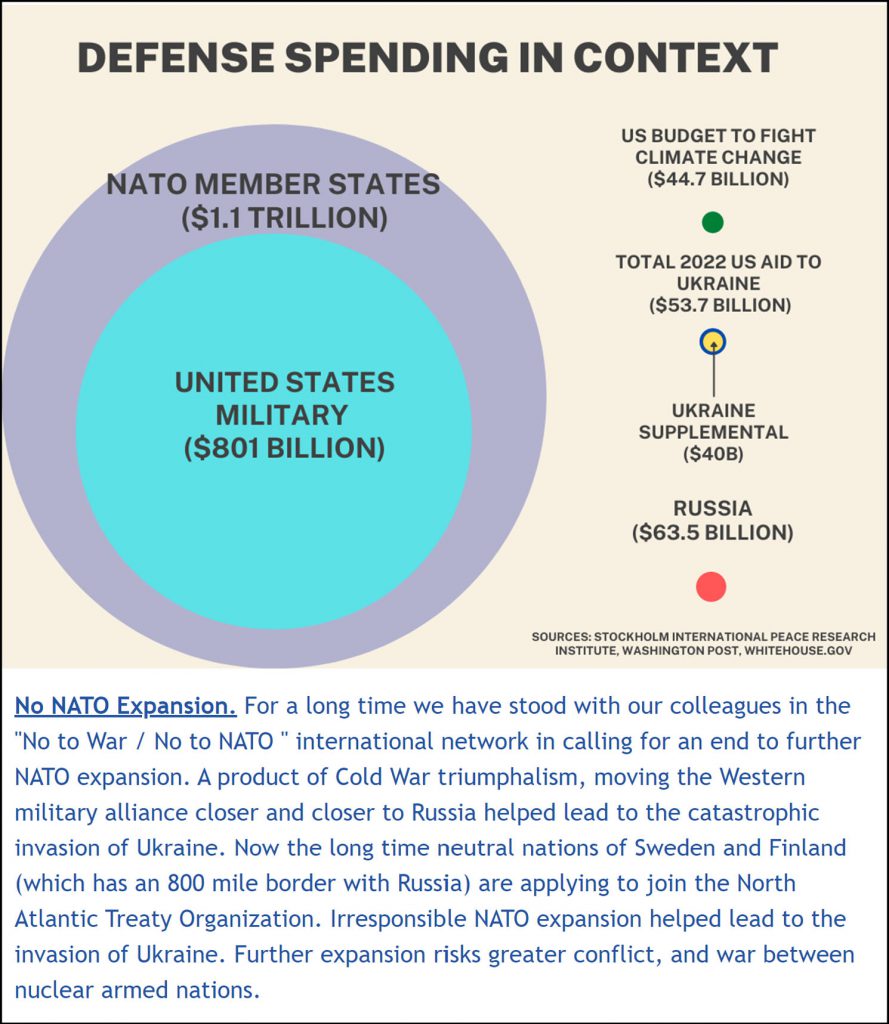QUOTE OF THE WEEK
Nothing Found
It seems we can’t find what you’re looking for. Perhaps searching can help.
LANL’s Central Mission: Los Alamos Lab officials have recently claimed that LANL has moved away from primarily nuclear weapons to “national security”, but what truly remains as the Labs central mission? Here’s the answer from one of its own documents:
LANL’s “Central Mission”- Presented at: RPI Nuclear Data 2011 Symposium for Criticality Safety and Reactor Applications (PDF) 4/27/11
Banner displaying “Nuclear Weapons Are Now Illegal” at the entrance in front of the Los Alamos National Lab to celebrate the Entry Into Force of the Nuclear Weapon Ban Treaty on January 22, 2021
Nothing Found
It seems we can’t find what you’re looking for. Perhaps searching can help.
Follow the Money!
Map of “Nuclear New Mexico”
Nuclear Watch Interactive Map – U.S. Nuclear Weapons Complex
In 1985, US President Ronald Reagan and and Russian President Mikhail Gorbachev declared that “a nuclear war cannot be won and must never be fought.”

Waste Lands: America’s Forgotten Nuclear Legacy
The Wall St. Journal has compiled a searchable database of contaminated sites across the US. (view)
Related WSJ report: https://www.wsj.com
2022 BLOG POSTS
Nothing Found
It seems we can’t find what you’re looking for. Perhaps searching can help.
New & Updated
Meet the Nuke Boss, Just Like the Old Boss!
While Obama’s rhetoric soars toward a grand nuclear weapons-free world, his Office of Management and Budget is getting ready to ask Congress for a 10% increase in research and production?
Apparently our president is preemptively surrendering to the 40 Republican senators +1 (“independent” Lieberman) that demanded linkage of ratification of a new Strategic Arms Reduction Treaty (START) with Russia to “modernization” of the nuclear weapons research and production complex, along with a “modern warhead,” whatever that is. A huge fight was always expected over a second round of attempted ratification of the Comprehensive Test Ban Treaty (CTBT. However, the Republicans +1 cunningly chose to move that fight up to START ratification in order to leverage Obama’s proposed FY 2011 federal budget slated for release on February 1. They apparently have succeeded: he has caved into them.
The Republicans seek to mandate the construction of two controversial new production facilities, the plutonium “Nuclear Facility” at Los Alamos and the Uranium Processing Facility at Y-12 near Oak Ridge, TN, both designed for production levels of up to 125 nuclear weapons per year. Additionally, groundbreaking for the new privately financed Kansas City Plant for nonnuclear components production, responsible for 85% of all components that go into U.S. nuclear weapons, will occur soon. Ironically, that may be just before the NonProliferation Treaty Review Conference that begins May 3 at the United Nations. We can expect Obama’s oratory to again excel at the UN while claiming that the U.S. is indeed working toward a nuclear weapons-free world. He will be contradicted by these new plutonium, uranium and nonnuclear nuclear weapons components production plants, together costing $7 billion or more.
Obama should put his money where his mouth is, not give it to the nuclear weaponeers. A decade ago Clinton and Congress delivered bucket loads of money to the nuclear weapons labs, only to have their directors damn the Test Ban Treaty through faint praise before the Senate in 1999 which killed it (and they got to keep the money!).
Today, the Labs internally state that there is little technical difference between a ratified Test Ban Treaty and the current testing moratorium in effect since 1992. Their real concern is to leverage treaty ratifications to ensure expanded design and production capabilities for both existing weapons and possible “replacement designs,” which they have not given up on despite previous congressional rejections of “Reliable Replacement Warheads.” They want to “Get more money” for expanded capabilities through Treaty “Safeguards.” They are apparently succeeding. ( more ).
Studies by independent nuclear weapons experts have concluded that the all important plutonium pit triggers last a century or more, and existing nuclear weapons can be reliably maintained under existing programs for many decades. In pending budget and treaty ratification processes our New Mexican Senators should be pushing for increased funding for alternative missions and cleanup at our Sandia and Los Alamos national labs, instead of supporting Obama’s preemptive surrender that will further entrench our state in the nuclear weapons business. That is the right thing to do for both the long-term creation of jobs in New Mexico and working consistently toward a nuclear weapons-free world.
Given exploding national debt the American taxpayer should not be further burdened with unneeded and provocative nuclear weapons production facilities. The labs want to pervert disarmament treaties into armament treaties by enshrining expanded nuclear weapons design and production capabilities for themselves as treaty “Safeguards.” Hope we don’t get fooled again!
Kansas City (Nuke Plant) Blues
Some pertinent points on the new Kansas City Plant, prompted by the Kansas
City Star article:
• Groundbreaking will probably be sometime after March given that final
private financing still has to be found.
• However, groundbreaking for a major new U.S. nuclear weapons production
plant, costing $4.76 billion to build and operate over its first 20 years,
is still likely to occur just before the May 2010 NonProliferation Treaty
Review Conference. It would be nice if the U.S. had some explaining to do at
the UN over that.
• Originally reported construction cost was $500 million. Now we’re up to
$673 million.
• Previously projected tax abatements to be granted by the Kansas City
municipal government were $41 million. Now we’re up to $65 million ($2.6
million/year over 25 years).
• Infrastructure improvements (roads and utilities) enabled by the tax
abatements will benefit the private developers in their other nearby
business ventures, including a planned intermodal,international
transportation hub (part of the so-called “NAFTA Superhighway”).
• Kansas City’s Planned Industrial Expansion Authority (PIEA), enabled by
Missouri state law to fight urban blight, will issue bonds to private
investors. The PIEA declared a producing soy bean field blighted in order to
provide the basis for this (hardly urban blight).
• Through the PIEA, a municipal government (Kansas City, MO) will hold fee
simple to this new federal nuclear weapons production plant (i.e., own it).
The PIEA will grant the private developers a 20-year or more
lease-to-purchase, after which the private developers will own this new
federal nuclear weapons production plant.
• Guaranteed subleases to the National Nuclear Security Administration
(NNSA) via the General Services Administration (GSA) effectively guarantee
the profits of the private developers and their ability to pay the bonds
off. “Coincidentally,” one of the two private development partners happened
to own the land that the new Plant is to be built upon before GSA/NNSA
selected it.
• GSA/NNSA put out a solicitation for bids to private developers a good
month or so before they issued public notice of an environmental assessment
for the new Kansas City Plant under the National Environmental Policy Act.
Nevertheless, the two agencies have always denied any predetermination.
Sandia Claims Technology Supports the CTBT While Modernizing Weapons
Above its masthead the hard copy 12/4/09 Sandia Lab News has a cool NNSA/DoD “W76-1/MK4A” badge with a black submarine and a vertical warhead above it with a slanted trident across it. MK4A is the reentry vehicle for the W76. The sub, of course, is a Trident submarine.
To summarize some points:
• It states that Life Extension Programs (LEPs) can extend warhead life up to 60 years. That’s significant, especially given the continuing push by some for new-design replacement warheads. Previously I had heard only up to 30 years.
• Please note the pending resumption of broad-scale nuclear weapons production with this W76 LEP.
• Please note “reinventing the weapon’s AF&F [arming, fuzing & firing] system” …. which “provides packaging and performance enhancements. Though the W76-1 is emphatically not a new weapon system, the scope of the LEP effort was very demanding.”
Maybe it’s not a new “system,” but the W76-1 has new military characteristics. That new AF&F system being produced now at the Kansas City Plant is believed to endow the warhead with a selectable height of burst.
In 1997 Navy Admiral George “Pete” Nanos wrote :
The demonstrated capability of the D5 [the new Trident II missile] is excellent. Our capability for Mk 4 [reentry vehicle with W76 warhead], however, is not very impressive by today’s standards, largely because the Mk 4 was never given a fuse that made it capable of placing the burst at the right height to hold other than urban industrial targets at risk. With the accuracy of D5 and Mk 4, just by changing the fuze in the Mk 4 reentry body, you get a significant improvement. The Mk 4, with a modified fuze and Trident II accuracy, can meet the original D5 hard target requirement. Why is this important? Because in the START II regime, of course, the ICBM hard target killers are going out of the inventory and that cuts back our ability to hold hard targets at risk.
“Strategic Systems Update,” Rear Admiral G.P. Nanos, The Submarine Review, April 1997
In other words, with a new fuze and increased missile accuracy the military characteristics of the refurbished W76-1 are transformed from being a countervalue weapon of deterrence (“city buster”) into a counterforce weapon (“hard target killer”). This directly contradicts the constantly repeated statements by senior U.S. Government officials that military characteristics won’t be changed and that “new” nuclear weapons will not be created.
For more, please Hans Kristensen’s excellent 2007 “Administration Increases Submarine Warhead Protection Plan”
(Side note: Adm. Pete Nanos later became LANL Director, didn’t quite get along, and at one point famously called Lab scientists “cowboys” and “buttheads”).
The article ends by noting that the W76 LEP has laid the foundation for a future B61 LEP, which itself is an issue of current controversy.
Separately it was recently revealed that Sandia manager Lockheed Martin pays Sandia Director Tom Hunter $1.7 million a year. Lockheed Martin is also the dominant corporate partner running the U.K’s Atomic Weapons Establishment (AWE) at Aldermaston. On December 4 the Obama Administration nominated Donald Cook to be NNSA Deputy Administrator for Defense Programs. Cook is an American who worked at Sandia for 28 years and was the Managing Director of the UK’s AWE from 2006 to 2009. The W76 is the U.K’s main (if not only) currently operational nuclear weapon.
I find the overarching headline in this e-version of Sandia Lab News announcing that Sandia technology “comprehensively” supports the CTBT to be ironic while it then goes on into an article about broad-scale nuclear weapons production of the W76-1. I understood the original intent of the CTBT to be a disarmament treaty cutting off the further advancement of nuclear weapons by any country.
Update – Lab Shipment Scare at Sunport
Phil Parker at the Journal gives an update.
The package was labeled “explosives” on the inside, so the cargo handlers were rightfully concerned when their alarms went off. The cargo facility was closed for about four hours during the incident.
It was reported that , “The containers are usually shipped via ground transportation but sometimes, he [LANL spokesperson] said, they’re sent by air.” I’m guessing that it costs more to send it by air, not to mention the extra cost of wasting time of the Albuquerque Police Department bomb squad, the cargo handlers, and Lab personnel.
The Journal reported, “Security at the airport didn’t know about the arrangement. “Apparently it was just a misunderstanding,” said airport spokesperson Daniel Jiron.” Once again, the Lab deflects any responsibility.
Lab Tries To Ship Explosives on Commercial Airline
KOB TV 4 broke the story and is still has the only account as best as I can tell. Read report and see video here.
Los Alamos National Laboratory sent an 8’ package labeled “explosives” to the Sunport to be flown to California on Southwest Airlines (where bags fly free). A sensor alarm alerted the cargo handlers to “a small amount of trace explosives” and the package never made it to the plane. It was reported that no flights were delayed and there was no danger. It was also reported that the Lab meant to ship the package by ground.
The danger here is that the Lab which is entrusted with the nation’s nuclear secrets cannot ship a package correctly. It was an 8’ package labeled “explosives.” It’s not like it got accidently mixed in with other packages and put on the wrong truck.
The public deserves all the facts. How did the “mix-up” occur? Has the Lab shipped similar packages before? What type of “explosive” label did the package have on it? Did it meet all shipping standards for explosives? Did the explosives pose a detonation hazard? Could the package really have been shipped by ground? How does an 8’ package labeled “explosives” even get unloaded into the air cargo building?
Lab’s Cyber Security Still Not Trustworthy
A GAO Report released Friday the 13th found that “significant information security control weaknesses remain on LANL’s classified computer network. LANL had vulnerabilities in several critical areas, including (1) identifying and authenticating the identity of users, (2) authorizing user access, (3) encrypting classified information, (4) monitoring and auditing compliance with security policies, and (5) maintaining software configuration assurance.”
The report explains that LANL spent approximately $433 million from fiscal years 2001 through 2008 to operate, maintain, protect, and procure equipment for its classified computer network. The largest expenditure for the classified computer network was for high-performance computing, which accounted for $322 million (or 74 percent) of total expenditures. LANL began to expand the classified computer network in 2005, accounting for $48 million (or 11 percent) of total expenditures during the fiscal year 2001 through fiscal year 2008 period. Expenditures for special initiatives, such as the Integrated Cyber Security Initiative and Multi-Platform Trusted Copy program, accounted for $19 million (or 4 percent) of total expenditures. The core classified cyber security program, which serves as the foundation of LANL’s protection strategy for the classified cyber security program, accounted for $45 million (or 10 percent) of total expenditures over the period.
Clearly, the Lab was more focused on high-performance computing rather than focusing on protecting the nation’s nuclear secrets, or maybe the Lab thought everything was OK.
This GAO report comes after the DOE Office of Enforcement devoted significant attention to monitoring compliance with a Secretarial Compliance Order that was issued in July 2007. Specifically, the DOE Secretary directed the contractor for the Los Alamos National Laboratory – Los Alamos National Security, LLC – to remediate deficiencies that contributed to a breach of classified information security controls and to correct longstanding deficiencies associated with classified information security, and classified and unclassified cyber security programs. Los Alamos National Laboratory reported that the actions were completed by December 2008, and the DOE Los Alamos Site Office formally validated completion of the required actions.
But problems were still not corrected. To satisfy the above July 2007 DOE Compliance Order, the laboratory reaccredited all classified computer systems. During 2008, as part of its reaccredidation process, LANL revised risk assessments for classified computer systems and included the results in the system security plans. However, of the five system security plans the GAO reviewed, one plan’s risk assessment did not adhere to the latest methodology and did not include evidence of a comprehensive threat analysis, as required by DOE. Furthermore, the remaining four plans noted that all known threats and vulnerabilities were not evaluated to determine risks. Without comprehensive risk assessments, risks to certain systems may be unknown and appropriate controls may not be in place to protect against unauthorized access to or disclosure of sensitive information, or disruption of critical systems and operations.
What’s the problem? A Special Report from the Government Computer News tells us –
According to data reported by the U.S. Computer Emergency Readiness Team (US-CERT), reported attacks on U.S. government computer networks climbed 40% last year, and more infiltrators are trying to plant malicious software they could use to control or steal sensitive data. Accounts of unauthorized access to government computers and installations of hostile programs rose from a combined 3,928 incidents in 2007 to 5,488 in 2008, The latest report, issued in February 2009, represented a small sampling – just 1% of federal agencies have fully developed tracking systems – and some of the uptick in reported attacks may be due to better reporting in the last year.
Government networks are targeted by foreign nations seeking intelligence, such as China and Russia, as well as criminal groups and individuals who may want to disrupt power, communication or financial systems. Some attackers are less interested in stealing data than in undermining a system’s ability to operate by planting software that could slow critical networks in emergencies. Security industry observers expressed alarm about phishing, in which seemingly legitimate e-mails solicit sensitive information, and ‘web redirects,’ which shunt a computer to a website where it downloads malicious software. According to reports, fewer attacks are being used to take down an organization’s entire IT system. Instead, attacks now penetrate IT systems without impairing them, primarily to siphon out sensitive information without detection.
Complete excavation of Area G now estimated at only $9.1 billion
Q: How much does it cost to cleanup a 65-acre, 50-year-old, nuclear weapons laboratory unlined dump full of low-level radioactive waste (LLW), radioactively contaminated infectious waste, asbestos contaminated material, transuranic waste, polychlorinated biphenyls (PCBs), and much more?
A: About 8 years of the Lab’s nuclear weapons activities budget.
First, define cleanup. (Closure is the better term to use.)
The Lab recently submitted a revised (September 2009) corrective measures evaluation (CME) of Material Disposal Area (MDA) G, located within Area G of Technical Area 54, at Los Alamos National Laboratory to the NM Environment Department. The goal of the CME report was to recommend a corrective measures alternative for closure of the site and to address contamination releases in compliance with the March 1, 2005, Compliance Order on Consent (Consent Order).
This CME report screened 14 corrective measures alternatives based on their ability to meet the regulatory threshold and other qualitative screening criteria. Seven of the 14 alternatives evaluated met the screening criteria and capital costs were estimated:
1. Alternative 1B: maintenance of existing cover – $9.4 million;
2. Alternative 2B: evapotranspiration (ET) cover – $64.8 million;
3. Alternative 2C: ET cover with partial waste excavation – $46.5 million;
4. Alternative 2D: ET cover with partial waste excavation, targeted stabilization – $48 million;
5. Alternative 5B: complete waste excavation, waste treatment, off-site disposal – $9.1 billion (This is down from last year’s estimate of $20 billion.);
6. Alternative 5C: complete waste excavation, on-site waste treatment, disposal of wastes in a RCRA Subtitle C landfill – $6.1 billion; and
7. Alternative 5D: complete waste excavation, on-site waste treatment, disposal of wastes in a RCRA corrective action management unit – $6.1 billion.(All alternatives include monitoring and maintenance, and soil vapor extraction, but don’t include a 55% contingency.)
The Lab’s recommended corrective measures alternative is Alternative 2C.
The right thing to do would be Alternative 5B, complete waste excavation. The Lab could cover the $9.1 billion by redirecting the $1.2 billion it spends annually on nuclear weapons activities.
The hard-working folks over at NMED have to make the final decision, and there will be opportunities for public input.
Find the report MDA G CME R1 Sept 09 [Warning, it’s 14MB]
What NIF Might Do?
The gist of NNSA’s important announcement: After $5 billion and counting,
(emphases mine)
NIF’s laser beams CAN BE effectively delivered and ARE CAPABLE of creating sufficient x-ray energy to drive fuel implosion, an important step toward the ultimate goal of fusion ignition.
Further,
NIF will be a cornerstone of a critical national security mission, ensuring the continuing reliability of the U.S. nuclear stockpile without underground nuclear testing…
This is more of Tom D’Agostino’s positioning of NIF as essential for CTBT ratification (which he has done face-to-face to me and others). That’s not a prudent deal, to hinge CTBT ratification on what NIF “MIGHT” be capable of.
… while also providing a path to explore the frontiers of basic science, and potential technologies for energy independence. It is a prime example of how our investment in nuclear security is providing the tools to tackle a broad range of national challenges.
Is there nothing NIF can’t do? Recall that exactly a year ago tomorrow they had Terminator Gov. Schwarzenegger going “gee whiz,” as follows:
This laser technology has the potential to revolutionize our energy future,” Governor Schwarzenegger said. “If successful, this new endeavor could generate thousands of megawatts of carbon-free nuclear power but without the drawbacks of conventional nuclear plants. This type of innovation is why we are a world leader in science, technology and clean energy, and I could not be prouder that this work is happening right here in California.
Speaking for myself, I will grudgingly concede that NIF has succeeded in its real mission of ensuring that the Lawrence Livermore National Laboratory survives as a nuclear weapons lab (NIF-specific funding is 25% of all DOE funding for LLNL). In 1995 the Galvin Commission recommended eliminating the redundancy of having 2 nuclear weapons design labs and ending weapons programs at Livermore. Then rose NIF…..
The bolded emphases on NNSA’s repeated use of qualifying language and future tense is mine. Does this press release really say anything of substance at all?
Operations at Plutonium Facility stood down due to fire suppression system
In the latest of a string of fire system deficiencies on Wednesday September 30th, LANL management declared the fire suppression system inoperable in PF-4 at TA-55. Facility activities were placed in stand-by mode, which were still stood down as of three weeks later on Oct. 23rd.
DNFSB explained that the stand down was based on recent hydraulic calculations that concluded the system does not achieve the water density coverage required. Basically, the sprinklers in 13 of approximately 100 fire suppression areas at PF-4 cannot meet the current required gallons per minute estimated to effectively extinguish a fire. (Read the Oct. 2nd-23rd DNFSB reports)
One has to wonder – What is the cost to the taxpayer of PF-4 being stood down for nearly a month?
These reports come on the heels of last week’s DNFSB recommendation that the Lab must immediately do something about its risk to the public of a seismically induced fire at PF-4, which was estimated to exceed the DOE guidelines by more than 100 times. In a worst-case situation, an earthquake-induced fire could set free enough breathable plutonium that a person on the perimeter of the facility would receive a lethal dose of radiation.
Speaking of seismically induced fires, I am reminded of a March 2007 LANL report, Seismic Fragility of the LANL Fire Water Distribution System (LA-14325), which explains how numerous valves in the fire water distribution system at the Lab would have to be manually closed to insure proper pressure to facilities on fire after a seismic event.
Granted, these may be low probability events, but they have high consequences. The Lab is playing with fire by not adequately funding upgrades to its existing fire systems now, before embarking construction of any new facilities.
(Un)Reliable Replacement Rationale
In this YouTube video Energy Secretary Chu and Tom D’Agostino celebrate the Kansas City Plant’s 60th anniversary with a plaque mounted with vacuum tubes for the B61 radar unit. STRATCOM chief Chilton has repeatedly used the presence of vacuum tubes in the nuclear weapon as a rationale for complete new-design nuclear weapons (the Reliable Replacement Warheads, or facsimiles thereof), instead of modernizing just the radar.
Meanwhile, the National Nuclear Security Administration and the General Services Administration are engaged in a complex scheme for private financing of a new Kansas City Plant for which the Kansas City municipal government will hold title because of municipal bonds issued to finance its road and utility infrastructure. This is enabled by Missouri state law, which gives tax abatement authority to municipal governments in order to fight urban blight. In this case, 185 acres primarily used for soybean agriculture was declared blighted in order to grease the deal. The result: a city government owning a federal nuclear weapons production plant in the name of fighting urban blight!
Historically, the Kansas City Plant has manufactured and/or procured 85% of all types of nuclear weapons components by volume. KCP was excluded from analysis in the Complex Transformation Supplemental programmatic environmental impact statement because NNSA falsely argued that its nonnuclear components production mission would not be affected by decisions made elsewhere in the nuclear weapons complex. Au contraire, the rationale for the new Kansas City Plant was originally predicated upon extensive production of new Reliable Replacement Warheads and Life Extension Programs involving existing nuclear weapons numbering in the 1,000’s.
Hopefully that rationale is now seriously outdated.
Los Alamos Director Anastasio’s Two Hats
Apparently the National Nuclear Security Administration reimburses Los Alamos National Security LLC (LANS) $397,341 for LANL Director Anastasio’s salary. Then LANS LLC pays him another $400K to promote the NNSA agenda from which LANS LLC derives a profit. During all this time Anastasio also acts as President of the for profit LANS (for which he gets a combined total of $800K).
Which hat does Anastasio then wear when the country needs his best advice? Obama wants the Comprehensive Test Ban Treaty ratified as one beginning step toward a nuclear weapons-free world. The Labs want the Senate to attach “Safeguards” to the Treaty during the ratification process that will have the contrary effect of enshrining nuclear weapons design and production capabilities into perpetuity. LANS profits from those capabilities. How do we know that Anastasio will give untainted advice on serious questions such as whether this country will genuinely lead toward enhanced global security through the verifiable multilateral elimination of nuclear weapons?
For more on what the nuclear weapons labs want through CTBT Safeguards see our September 2009 press release:
Labs Seek “Stockpile Modernization” Through Test Ban Ratification “Updating” of Treaty “Safeguards” to Protect Nuclear Weapons Budgets
Weapons Lab Director Paid Double the Salary of Nobel Peace Prize-Winning President Obama
Santa Fe, NM – On December 10 President Barack Obama will receive the Nobel Peace Prize in Oslo, Norway for his beginning efforts to abolish nuclear weapons. The President is paid $400,000 a year for running the country. Michael Anastasio, the Director of the Los Alamos nuclear weapons lab in northern New Mexico, is paid double that of the President, $800,348 a year. Unlike the President, Mr. Anastasio has been an unabashed supporter of new-design nuclear weapons and resumed industrial-scale nuclear weapons production. Over 60% of the Lab’s $2.1 billion annual budget is specifically dedicated to nuclear weapons research and production, while much of its remaining budget supports those core programs.
It is profoundly regrettable that so much taxpayers’ money is misdirected toward nuclear weapons of mass destruction, contrary to the spirit of the Peace Prize that President Obama is about to receive.
Hikers, dogs found inside the fence
From October 26 – 30, 2009
Near Miss –
• NA – Los Alamos National Laboratory (Significance Category 3). On October 22, a Water
Quality sampling crew discovered two hikers with three dogs at Technical Area 68 (TA-68)
during High Explosive (HE) Operations. The hikers were instructed to exit DOE property.
During interviews, the hikers stated they had hiked approximately one mile into TA-15.
During that time, TA-39-6 conducted two HE shots. A third shot scheduled for another shot
site was cancelled because of equipment issues. The hikers did not enter the TA-39-6 shot
Hazard Areas. Had the third shot been conducted, the hikers could have been within the
Hazard C Area with the potential for contamination or HE injury. A radiological control
technician surveyed the hikers and dogs for contamination. The contamination surveys
indicated no detectable activity and the hikers were released.
http://www.hss.energy.gov/csa/analysis/ll/occur/102609-103009.pdf
I’m glad everyone is OK, but I have some questions. The hikers clearly crossed a fence or a gate with one of those warning signs on it. There is no mention of security forces being called. The Lab has been busted for security issues many times in the past and can ill afford any more security problems. Is it possible that the Lab is trying to avoid having this incident count as a security violation? If they found me walking my dogs inside the fence, I’ll bet I would at get to explain my story to the guys in the black SUVs.
Los Alamos – Plutonium Center of Negligence
An October 27 press release from the Project on Government Oversight (POGO)
“Defense Board Catches Los Alamos Trying to Dodge Plutonium Safety Vulnerability” revolves around a new Defense Nuclear Facilities Safety Board (DNFSB) revelation of public safety vulnerability and seismic issues at TA-55 (The Lab’s plutonium Technical Area).
The DNFSB has been very patient on the safety issues at TA-55. In a September 23, 2005 weekly report, they stated that LANL needed to try to justify a passive confinement strategy, continue plans to reduce radioactive materials, and to seismically upgrade the glove-box supports that have not already been upgraded. These issues are still unaddressed as of the latest DNFSB report.
Seismic issues run deep at Los Alamos. NNSA currently has plans to construct and operate the Chemistry and Metallurgy Research Replacement–Nuclear Facility (CMRR–NF) to support plutonium operations as a replacement for portions of the Chemistry and Metallurgy Research (CMR) facility, a 1950’s structure that faces significant safety and seismic challenges. In 1999, a fault was discovered under the old CMR building, which has been neglected, contaminated, and has several abandoned wings. This fault was the major reason given to build a new facility 1.2 miles away at TA-55.
The Lab has big plans for plutonium. In December 2008, NNSA released a Record of Decision for its Complex Transformation Environmental Impact Statement that keeps manufacturing and research and development involving plutonium at Los Alamos and blesses the building of the CMRR-NF. This decision was a combination of two alternatives – a Distributed Centers of Excellence and a Capability-Based alternative. But to compensate for the nearby fault lines, the CMRR-NF is now being designed with 10-foot thick concrete floors and there are plans being designed to pump grout into a layer of fragile volcanic ash under the proposed facility. Current construction estimates for this facility are $2 billion.
The Lab has been negligent in taking care of its plutonium flagship, TA-55. It has not been a good steward of plutonium missions. Los Alamos is the wrong location, seismically. Congress must seriously consider ending this unnecessary plutonium work.
ACTION ALERTS
Nothing Found
It seems we can’t find what you’re looking for. Perhaps searching can help.
Nothing Found
It seems we can’t find what you’re looking for. Perhaps searching can help.
Interfaith Panel Discussion on Nuclear Disarmament - August 9
Nothing Found
It seems we can’t find what you’re looking for. Perhaps searching can help.
New Nuclear Media
Nothing Found
It seems we can’t find what you’re looking for. Perhaps searching can help.




